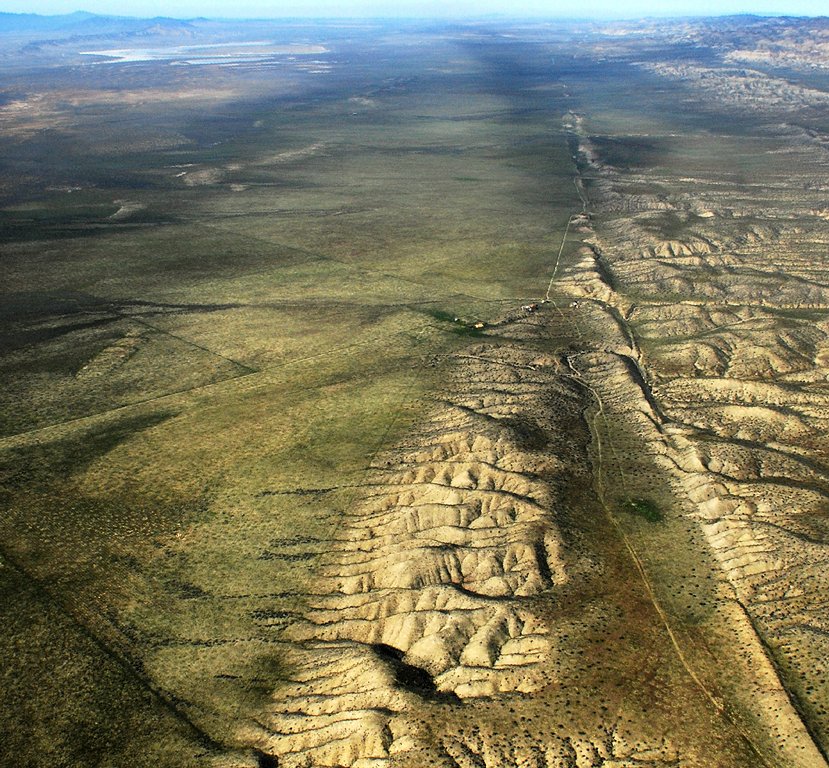A recent study shows that seismic hazard analyses can be improved by connecting more faults in an earthquake forecasting model.
By Jeng Hann Chong, Cal State University Northridge
Citation: Chong, J.H., 2021, Connecting faults improves earthquake forecasting models, Temblor, http://doi.org/10.32858/temblor.157
During hurricane season, meteorologists forecast the path of storms days ahead of landfall. Similarly, earthquake scientists use earthquake forecasting models to estimate the probability of earthquakes of a certain magnitude striking specific areas for a particular timeframe. Just like meteorologists use different tools to study and track hurricanes, earthquake scientists use information gleaned from known faults, such as fault length and three-dimensional fault geometry, to develop their forecasting models. As scientists discover and study new faults, they are starting to consider whether separate faults can connect to one another during an earthquake because different assumptions of rupture length can change calculations of seismic hazard risk.
A study published in 2018 suggested that the most widely used earthquake forecast model for California —the Third Uniform California Earthquake Rupture Forecast (UCERF3) — used by the U.S. Geological Survey and insurance companies, includes too many earthquake ruptures that are longer than known historical earthquake ruptures (Schwartz, 2018). This would imply that the model does not accurately predict hazard in California. However, a new study demonstrates the opposite: relative to older models with short, segmented faults, the UCERF3 model actually better matches the recorded frequency of known rupture lengths by allowing for more fault connections.

Addressing misconceptions
In the earlier study, scientists compared historical earthquake rupture lengths to all possible rupture lengths in the UCERF3 model, says Morgan Page, a geophysicist at the U.S. Geological Survey in Pasadena, Calif., and author of the new study. She says this is not the appropriate comparison to make.
In the model, hundreds of thousands of possible scenarios with different earthquake rupture lengths are produced, including very long ruptures, Page says. Of these scenarios, some are more likely to happen than others. Therefore, the appropriate comparison would not focus on every possible rupture length in the model, but rather the rupture lengths of the most likely scenarios. This group of model rupture lengths, Page says, can then be compared to the known historic rupture lengths. Contrary to Schwartz’s comparison, Page found that increasing fault connectivity in the model — which results in longer modeled fault rupture — actually improves the comparison between the model and reality.
When the model has fewer connecting faults, it instead generates too many earthquakes of moderate magnitude than is recorded by historic earthquakes, says Ray Weldon, a geologist at the University of Oregon who was not part of this study. The best way to solve this problem, Weldon says, is to allow the model to produce more large magnitude earthquakes by allowing for longer fault ruptures.
Multifault rupture reality
Another argument for fault connectivity is that we know multifault ruptures happen, Page says. “That’s an argument for [testing fault] connectivity [in these models],” Weldon says.
Examples of multifault earthquakes include both the 1992 magnitude-7.3 Landers earthquake in Southern California and the 2016 magnitude-7.8 Kaikoura earthquake in New Zealand. In particular, the 2016 Kaikoura earthquake ruptured more than 20 faults, some of which were previously unmapped. Forecasting models for such multifault events might not produce the exact scenario describing which faults will connect, but these models can better estimate the realistic maximum magnitude. This is more important for seismic hazard and more feasible than predicting the exact details of every possible earthquake, Page says.

Implications for earthquake forecasting models
Because the forecasting model allows for earthquakes with long ruptures, the model necessarily produces large magnitude earthquakes that are also less likely to occur, says Weldon. He adds, this reduces the probability of the model producing moderate earthquakes as well.
Earthquakes of moderate magnitude drive the insurance rates for the average household in earthquake-prone regions, and these rates would decrease with fewer moderate magnitude earthquakes in the forecasting model, Weldon says. On the other hand, he says, adding the possibility of less frequent larger magnitude earthquakes into the forecasting models affects how and where to build new long-term infrastructure, such as power plants.
The current model, which Page has helped construct, is a “giant step in the right direction and one can debate whether the step [having longer ruptures lengths] was a bit too far or not far enough,” Weldon says. To improve future forecasting models, he says, scientists should find a way to address how to account for unknown yet dangerous faults that cannot be easily identified by geologists.
Further Reading
Litchfield, N. J., Villamor, P., Dissen, R. J. V., Nicol, A., Barnes, P. M., A. Barrell, D. J., … & Zinke, R. (2018). Surface rupture of multiple crustal faults in the 2016 M w 7.8 Kaikōura, New Zealand, Earthquake. Bulletin of the Seismological Society of America, 108(3B), 1496-1520.
Page, M. T. (2021). More Fault Connectivity Is Needed in Seismic Hazard Analysis. Bulletin of the Seismological Society of America, 111(1), 391-397.
Schwartz, D. P. (2018). Past and future fault rupture lengths in seismic source characterization—The long and short of it. Bulletin of the Seismological Society of America, 108(5A), 2493-2520.
- Magnitude 7 Yukon-Alaska earthquake strikes on the recently discovered Connector Fault - December 8, 2025
- Upgrading Tsunami Warning Systems for Faster and More Accurate Alerts - September 26, 2025
- April 2025 magnitude 6.2 earthquake near Istanbul highlights strengths and weaknesses in seismic mitigation - September 14, 2025
